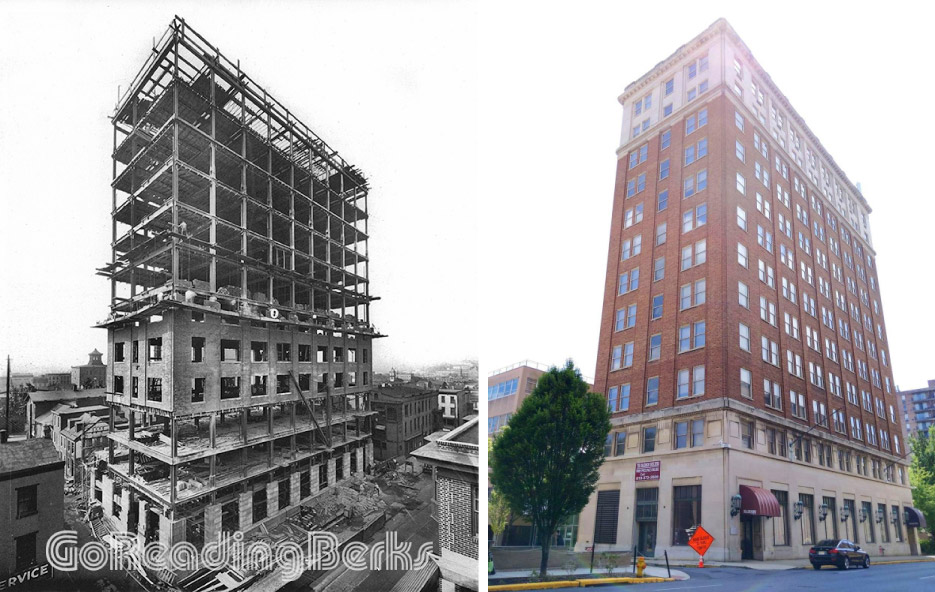Restoring the Madison Building in Reading, PA
Peter J. Marcucci
Photos Courtesy The Marble Restoration Company
Since 2014, The Marble Restoration Company has been restoring some of Pennsylvania’s most notable landmarks. Its newest undertaking, the Madison Building in downtown Reading, PA, is the latest example of what Rick Sirianni and his team of well-trained technicians can accomplish.
Built between 1926 and 1927, the Madison Building was originally constructed to house the Metropolitan Edison Company. Created in the distinctive Chicago skyscraper style and quite vogue for its day, its exterior features three distinct areas. Creamy Indiana Limestone adorns its base, while a reddish brown brick highlights its mid section, and a terra cotta-faced upper level is the icing on the cake. In its heyday, this 12-story work of art was the tallest structure in the city, topping out at just over 150 feet. Further adding to its grand presence, the structure was crowned by a huge sign 110 feet in length, bringing the building to a total of 210 feet above the sidewalk.
By 1952, the Madison Building had new occupants: the American Casualty Company. Later, others would fill its marble-clad interior until 1985 when, after many delays, the building’s aging interior received a much needed facelift.
Now, 35 years later, the historically registered building was again in need of a facelift to return the interior to its former majesty. However, a subtle surprise lay hidden, recalls The Marble Restoration Company’s Owner Rick Sirianni.
“At some point, the Madison Building had become a bank, because the lobby we uncovered was where tellers would help their customers. When we picked up the carpeting, there was about a half inch of mastic, cement, and all kinds of glue there. After we chipped away at it, I saw a marble floor and said, ‘Oh my goodness! Wouldn’t this be beautiful if the whole place had this marble floor?’ So the project manager called us in and I said, ‘Here’s the risk. We can take off all this mastic and cement and uncover a really damaged floor, or uncover a very beautiful restorable floor, but we won’t know until we do it.’ So they agreed to pay us to take the risk, and as it turned out, there was this beautiful marble floor of Travertine, green, black and brown marble that was in very good shape.”
The team did have to do about a hundred small repairs on the floor, but it restored beautifully, as well as the surrounding areas, including the Rosa Valencia columns, continued Rick. “There were Tennessee Pink marble window sills that were really damaged. We got them all filled and restored, and they looked beautiful.
“We didn’t have to restore the Cararra marble walls. We just did a deep clean on them using high-grit Shine Pro Diamond Impregnated Pads from BB Industries to bring them back to life. So the whole main lobby is now done, and we are way ahead of the development in the other parts of the building. We restored everything to its original beauty, including the gilded ceiling. It’s exciting that we were able to bring it back to its original shape.”
While Rick and the team performed the work on the first floor lobby, the upper floors were undergoing demolition. When finished, the first floor will be retail stores and a cafe, while the upper floors will be luxury apartments and a rooftop lounge. “They just gave us a contract to do the elevator lobby and one of the foyer entrances that are all marble walls and floors,” continued Rick. “In the foyer, the walls are so damaged, that we are restoring them by grinding them down, polishing, to bring them back to life. We’ve been using a lot of cleaner, Shine Pro Diamond Impregnated Pads, Stone Shield Sealer, Tenax Ager, and a lot of K-Bond Glue, all purchased from BB Industries.”
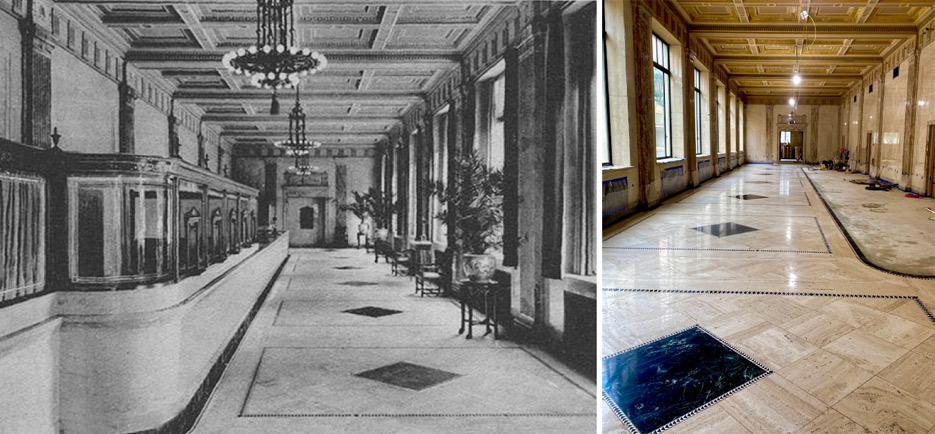 |
|
Above, left: The ornate Madison Building lobby, c 1929. Above, right: The lobby restoration in progress, with most of the floor cleaned, polished and restored to its former beauty. Over a half-dozen decorative marbles have been identified including Black Gold, Rosso Rupa, Verde Tino and Tennessee Pink. |
Key Issues Facing the Extreme Fix-It Team
Rick and company were brought into the job by project manager IPM Assist. The managers didn’t want to bring in new material. They just wanted the old materials restored. All phases of the work were done on a bid basis, not time and material. According to Sirianni, most key issues were just a matter of coordinating their work without affecting their other jobs. Fortunately, they were able to stretch out their scheduling by keeping only two to five technicians on the Madison Building job at any one time, he explained.
“It took a bit of juggling by Ms. Brynn Fiel, our VP of Operations. I don’t know how the heck she does it, but she is brilliant at scheduling. As for our guys, I am so darn proud of them. We have thirteen restoration experts and they all take the lead on certain jobs.”
When the team got shut down by the pandemic, Sirianni made the decision to keep everybody on the payroll, and told them that he didn’t know how long it was going to last, but the company could sustain this for three or maybe four months. If it were to go on longer than that, he’d give them a month warning to go collect unemployment. So he kept them employed, even though they weren’t doing anything.
“Their friends and families were really struggling, but after two months, business came roaring back, and we’ve been extremely busy since May. The guys – I don’t quite know how to explain it – they are so grateful. They are not only loyal to their work and take their craftsmanship very seriously, they are also all in for this company. They work as a team, they take care of each other and watch each other’s back, and I am really proud to be associated with them.”
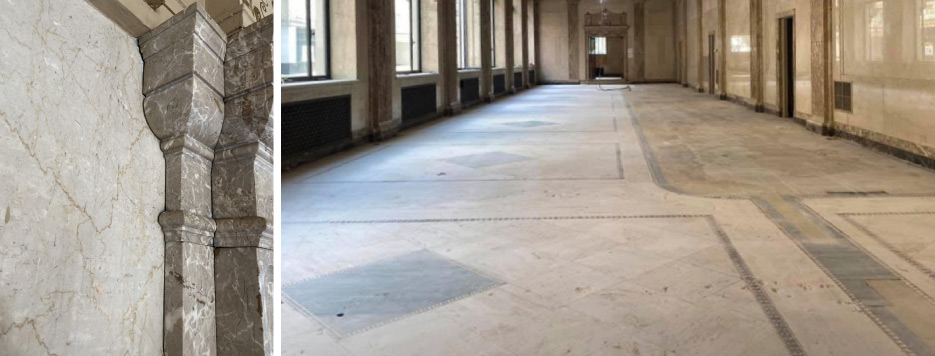 |
|
After stripping out the carpet and mastic, the entire floor was given a good cleaning, and polished one section at a time. Below, right: The Rosso Rupa marble triangles inset in the travertine floor run the perimeter of the lobby walls. Below, left: A Rosa Valencia marble baseboard runs the perimeter of the lobby, separated from the travertine and Rosso Rupa by a band of Black Gold marble. |
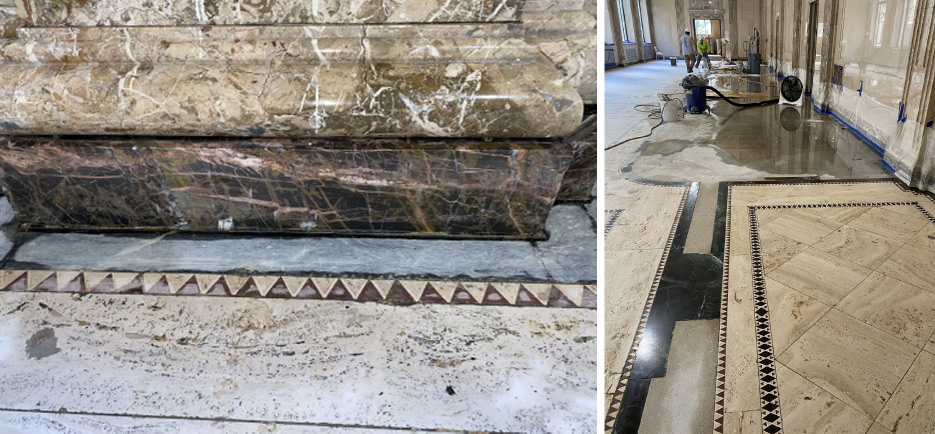 |
Sirianni also gave one of his junior guys, Joey DiCarlantonio, the opportunity to take the lead on this job. It was up to DiCarlantonio to organize it, plan the schedule, plan the purchasing, and review the scheduling with the administrative staff to make sure they were covered, he said. “Joey just stepped up and did a brilliant job, to the point where the whole team was writing him emails congratulating him. He kept it on schedule, and I’m really proud of him.”
Another Marble Restoration Company job in progress is the historic addition of the Manor House, a local nursing home. Through the warmer months, they’ve also been doing a lot of outdoor work throughout the old historic towns in the area that have brownstone houses and row houses with marble steps. Maintenance contracts are also a large part of the company’s revenue, and include a large office building owned by Tishman Speyer, the Four Seasons at The Comcast Center building, and the The Curtis Center.
Maintenance contracts are usually two and three years in duration, and when they include fabrication, there is only one company that they go through, said Sirianni: Michael Addesso Marble and Granite World. “They are pros, they are a multi-generational business, and they do all of our fabrication work. When our customers need fabrication, we call them. When their customers need maintenance work, they call us. It’s a great relationship!”
The Marble Restoration Company keeps an armada of 10 trucks that serve a 75-mile radius of the greater Reading area. Service also extends into central New Jersey, including the Jersey shore, and as far as Delaware.
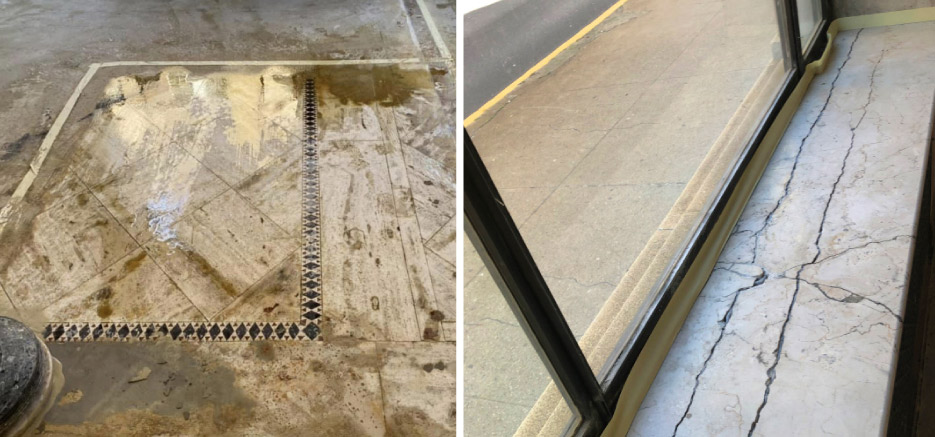 |
|
Above, left: With a general cleaning, the artistry of the floor began to shine through the grime of decades. Some of the basic restoration issues the crew overcame included removing mastic and glue, and repairing damage as necessary. Above, right: Many of the Tennessee Pink marble sills were badly damaged. The client wanted them repaired instead of replaced. |
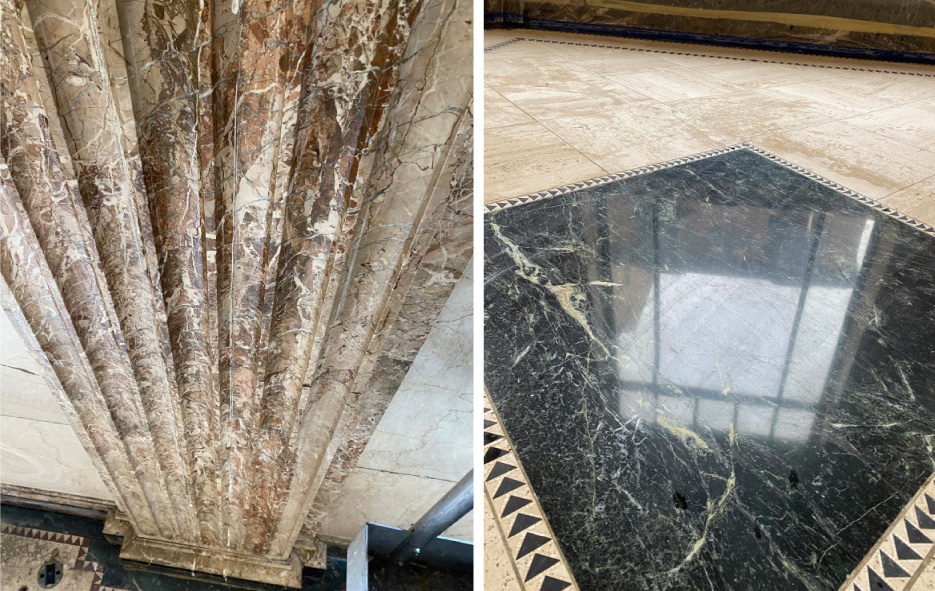 |
|
Above, left: The Carrara walls and Rosa Valencia columns mostly needed a thorough cleaning and polishing. Above, right: Large squares of green Verde Tino marble are a beautiful detail uncovered and restored. |
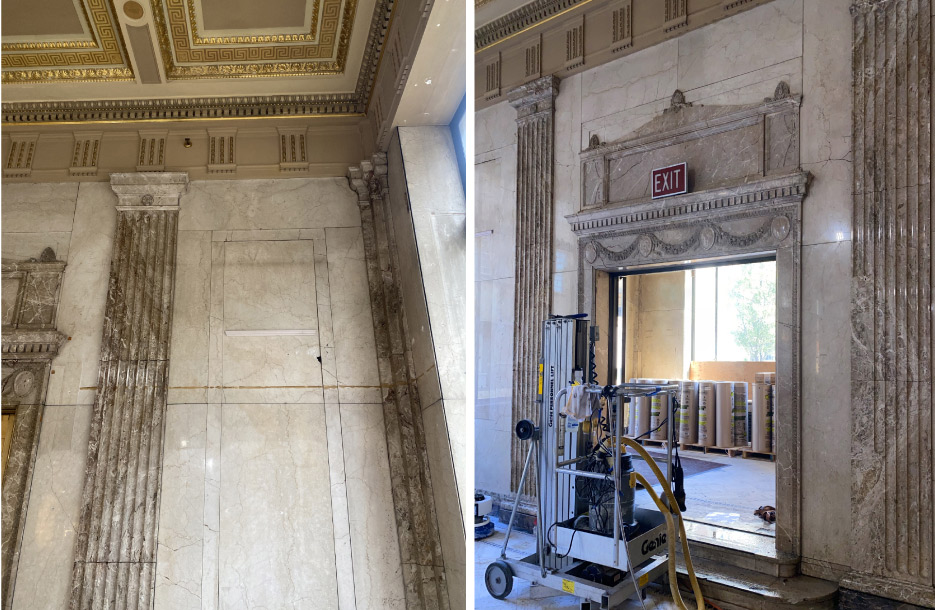 |
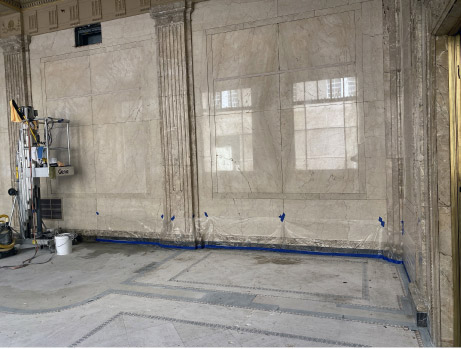 A Shining Example of What’s Possible
A Shining Example of What’s Possible
Reading, Pennsylvania’s prime was from the 1920s until the 1960s, when the economy fell apart after the local steel industry left. Currently, there’s a lot of redevelopment that’s revitalizing the area, and the renovation of the Madison Building is a shining example of this. Gentrification is on the horizon, and those willing to roll up their sleeves and put in the time will reap the rewards and the satisfaction of helping restore Reading’s proud heritage.
When The Marble Restoration Company techs first visited the Madison Building, they were concerned by the extent of the deterioration. “It was beat up and dirty, but when you stand in that main room, especially when you look at the ceiling, you could start to see the good bones of this building, and then we got challenged by it,” said Sirianni. “ Our guys love a challenge! ”
Sirianni explained that this restoration project was particularly hard work as they were restoring 20-foot- high walls. “They worked up on a lift or on ladders doing everything by hand. When you’re in the middle of a job and you’re dirty and you’ve got all this stuff going on around you, it’s hard to feel like you’re a craftsman or an artist. But when you step back and you see the final picture, and my guys are always sending me pictures of their final work, that’s when you really feel like a craftsman and artist. We love doing what we do.”
Sirianni admitted they were staying quite busy. “I could hire four more techs right now, because we have that much business. But I’m not going to hire just anybody. We are really particular, and (our work) uses some very unique techniques. But if I found a young guy who wanted to learn the craft and was willing to commit a year to study as an apprentice, I’d hire him in a heartbeat.”
For more information about The Marble Restoration Company, visit www.marblerestorationco.com .
A Reading Landmark
The Madison Building was erected between 1926 and 1927 as the Metropolitan Edison building. Towering more than 150 feet in the air, it was designed in the skyscraper style spearheaded by Louis Sullivan in the late 19th century in Chicago. The building, however, is distinctive in its exclusive use of Neo-classical detailing unique to Reading. The facade treatment divides the building into three distinct parts based on the classical column: the base or bottom portion, the shaft or middle portion and the capital or top of the building. A skeletal steel frame, constructed of steel weighing 14 pounds per square foot of total building area, supports the masonry exterior walls and building interiors.
The base of the building, rising about 30 feet above the sidewalk, is constructed of Indiana Limestone, with decoratively carved surrounding window and door openings. The neo-classical theme is repeated in the lobby.
